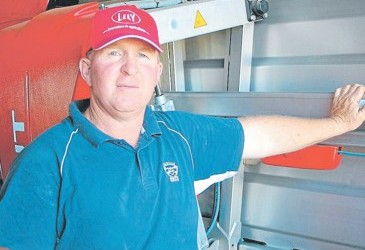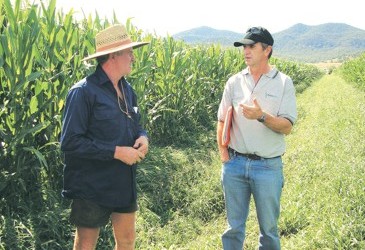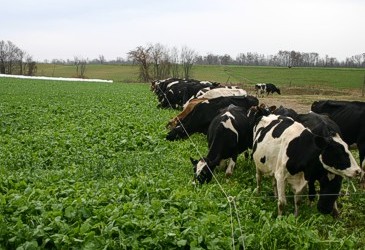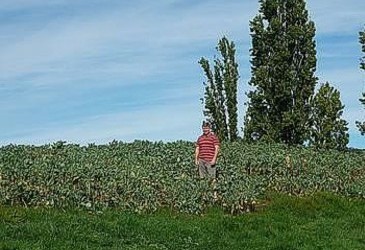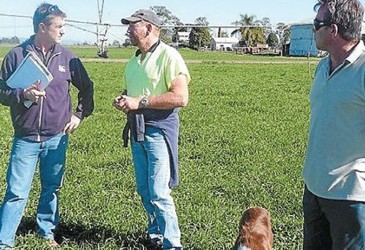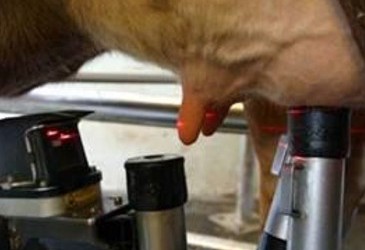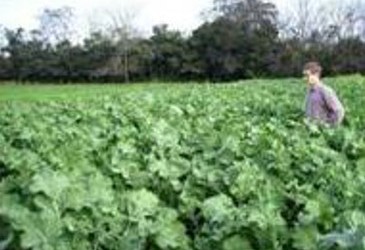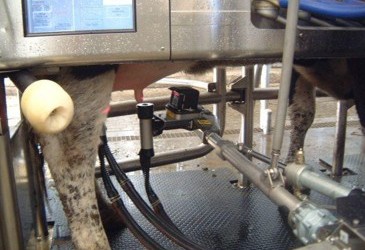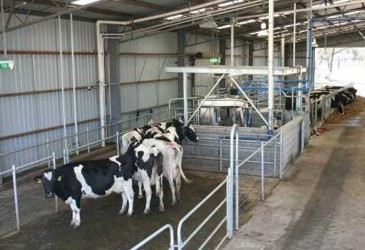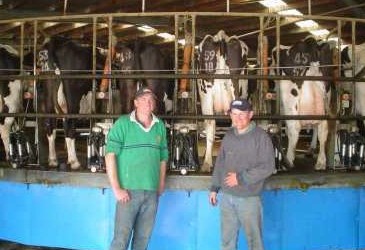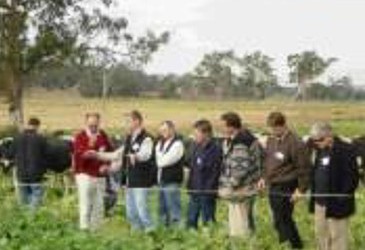The 3 P’s of robotic milking
Planning, preparation and practice – these are the keys to adapting to an automatic milking system (AMS), based on the experience of Western Victorian dairy farmers Terry and Danila Kavenagh who installed a robotic dairy last year. “It took a few weeks to get the hang of the robotic system but Lely was very supportive. However, real success relies on adapting your farming system to ensure cows move voluntarily to be milked and onto fresh feed. We’ve gotten better at that as we’ve built up experience,” said Mr Kavenagh
Breaking through the barriers
Hunter Valley dairyfarmers Ian and Maria Simpson are one of six valley dairying families working to break through the barriers to increasing their farm’s productivity. Working with Industry and Investment (I&I) advisers Anthea Lisle and Kerry Kempton the group is among the first dairyfarmers to apply FutureDairy’s Complementary Forage System (CFS) under commercial conditions.
Rape digestability
Recent research by the FutureDairy project has shown that forage rape (Brassica napus) holds its nutritional quality for more than three months after sowing, giving dairy farmers greater flexibility for grazing the crop. Forage rape, or brassica, is a useful way to fill the usual autumn feed gap on Australian dairy farms, due to its rapid growth, high quality, high potential yield, low establishment costs and efficient use of water and nitrogen.
Future options for dairy feed
The FutureDairy project is working with northern Victorian researchers and farmers to investigate new options for dairy feeds that may be suitable for farming in an uncertain climate. Project leader, Associate Yani Garcia, said the work would draw upon the principles of FutureDairy’s Complementary Forage System (CFS), adapting them for specific conditions in northern Victoria.
On-farm CFS trials
Six Hunter Valley dairying families are working to break through the barriers to increasing their farm’s productivity. Working with Industry and Investment (I&I) advisers Anthea Lisle and Kerry Kempton the group is among the first dairy farmers to apply FutureDairy’s Complementary Forage System (CFS) under commercial conditions. A CFS involves allocating a portion of the farm to intensive production to increase productivity from home‐grown feed.
AMS takes off in Oz
Over the past year, the Australian dairy industry has seen a marked increase in interest in robotic or automatic milking systems (AMS). Dr Kendra Kerrisk who leads FutureDairy’s AMS research at Camden, NSW said that people are still showing interest despite the current difficult financial times.
Flexible grazing options for forage rape
FutureDairy researchers have discovered that cows can be trained to respond to sound, opening up possibilities for teaching cows to come to the dairy in response to a particular call.
Robot Utilisation
Every new dairy involves a major financial investment and automatic or „robotic‟ milking systems (AMS) are no exception. FutureDairy‟s Dr Kendra Kerrisk takes a look at unit utilisation, a measure of how “busy” each automatic milking unit is on a given day. “We want to optimise unit utilisation, to make the most of the capital outlay involved in installing an AMS,” said Dr Kerrisk.
AMS system performance (high pasture utilisation at robotic dairy)
Despite the drought, FutureDairy’s automatic milking system (AMS) performance during 2007 confirmed that a pasture-based AMS can achieve very high levels of pasture utilisation with reasonable milk production and unit utilisation. Throughout the year, FutureDairy assessed the overall ‘farm system performance’ of its robotic milking system at Camden, NSW. To be successful under Australian conditions an AMS must operate with high pasture utilisation, high milk production and high unit utilisation.
Feeding system – the choice is yours
Forage rape is a brassica crop that provides good quality autumn feed for dairy herds
because it grows faster than most alternatives and it is as digestible as ryegrass.
Automatic heat and mastitis detection
FutureDairy researchers have discovered that cows can be trained to respond to sound, opening up
possibilities for teaching cows to come to the dairy in response to a particular call.
Automatic milking proves to be efficient system
Despite the drought, FutureDairy’s automatic milking system (AMS) performance during 2007 confirmed that a pasture-based AMS can achieve very high levels of pasture utilisation with reasonable milk production and unit utilisation.
Weather forecasting convert
Dairyfarmers, Sam and Fleur Tonge ignore the daily weather forecast, as it’s proven to be unreliable and irrelevant to their farming operations. However, detailed weather forecast data available on the internet has become an essential planning tool for both day-to-day farming activities and longer-term farming business decisions.
Working 9 to 5
FutureDairy’s milking staff Shannon Bennett and Terry Osborne quite like milking in a conventional dairy,
but after 18 months working in the automatic milking system (AMS) at Camden, they both say ‘you
couldn’t pay me enough to go back to the old system!’
Retrofitting a robot to an existing dairy
Dairy farmers frequently ask the FutureDairy team if it’s possible to fit a robot to an existing dairy,
especially a rotary. The concept appeals to those with a relatively new dairy which is still very functional. Automation already available in conventional dairies includes in-shed feeding, automatic cup removal (ACR), teat spraying and
drafting. So is automatic cup attachment (ACA) the next development for conventional dairies?
FutureDairy case study farms appointed
FutureDairy has announced that brothers Paul and Wayne Clarke and Wayne’s wife and Vicki have become
the project’s case study farmers for northern NSW.
FutureDairy is an industry project aimed at addressing the challenges farmers will face in the coming
twenty years. One of these challenges is increasing feed production with limited land, water and labour
resources.
Smooth start to FutureDairy
FutureDairy researcher, Dr Kendra Davis, and her colleagues were pleasantly surprised by the smooth start to the automatic milking system (AMS) at the Elizabeth Macarthur Agricultural Institute, Camden, NSW. “This is a high-tech dairy so we were expecting some teething problems with both the technology and getting the cows used to being milked by robots,” said Dr Davis who was a researcher with the Greenfield Project’s automatic milking system in New Zealand. “The commissioning process was far beyond my expectations and much better than my previous experience.”
FutureDairy expands into South Australia
FutureDairy – the project providing dairy farmers with practical innovations to address tomorrow’s challenges – is establishing a Partner Farm and trials in South Australia. Darren and Stephen Berkefeld from Mt Gambier will join three dairy farmers in Victoria as FutureDairy Partner Farms. Most of FutureDairy’s trials are conducted at the Elizabeth Macarthur Agricultural Institute (EMAI), at Camden, NSW.
An eye for the future
Most of us plan with a five to 10-year outlook and then get on with our daily business. Dairy farmers will be pleased to hear there‟s a group of researchers, advisers and farmers with an eye on the longer term future. As part of the FutureDairy team, their mission is to find ways to address the challenges dairy farmers are likely to face in the coming 20 years. Led by Professor Bill Fulkerson, at the University of Sydney‟s Camden campus, the project has the backing of the industry with sponsorship from Dairy Australia, NSW DPI and the University of Sydney.
Australia to adapt AMS technology
The FutureDairy project has announced it will collaborate with a leading milking equipment manufacturer, DeLaval, to develop a new concept automatic milking system to suit Australian conditions. FutureDairy Chair and dairy farmer, Shirley Harlock, said that automatic milking systems currently on the market had been developed for European dairying systems and needed to be adapted to suit Australia’s pasture-based system.

